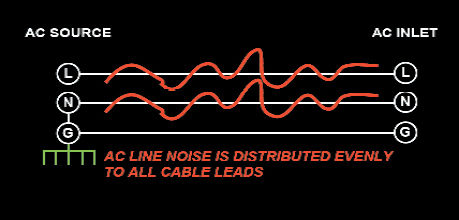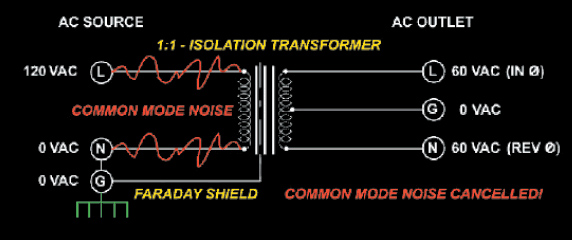
Pursuit Of Specifics
Given the “Murphy’s Law” situation of our profession, many times these problems happen to occur just before the concert or prior to your fixed system’s first “big show.”
Thus we arrive at a useful tool in helping to keep Mr. Murphy at bay, the AC isolation transformer.
As the name indicates, these devices are intended to isolate AC power (particularly incoming AC ground), thus eliminating the source of many AC problems.
In the pursuit of specifics that can lead to further understanding, let’s have a look at the primary types of AC noise as well as solutions to help with the problem.
Common mode noise attaches itself to AC lines in even proportion (both line and neutral wiring referenced to ground).
It comes primarily from AC fields and all 60-cycle harmonics, as well as a sizable portion of RF (radio frequencies) inducing noise into the AC line. (Figure 2)
Though some products are designed with some form of common mode rejection from input to output (such as most audio power amplifiers), the majority of products are still susceptible to performance corruption from induction of this noise into their circuitry.
The most frequently seen common mode noise rejection built into audio components offer “choke and capacitor filter” designs, and most certainly, many of these do aid in reducing the problem, particularly in terms of RF noise.

However, the addition of a symmetrically balanced transformer goes many steps further in reducing and often completely eliminating common mode noise across the audio and video bandwidth.
Symmetrically balanced power is achieved by running incoming AC power into a 1:1 ratio isolation transformer, with a precisely placed center tap on the secondary.
This takes the incoming voltage (120 volts on the line terminal, and 0 volts on neutral and ground) and splits it in perfect halves on the output secondary of the transformer.
Thus the output line terminal now has 60 volts AC while the neutral terminal also has 60 volts when referenced to its center tap ground, which remains at 0 volts AC. (Figure 3)

What’s significant about this is that the two 60-volt terminals are now in opposite polarity. So, like opposing magnets, the fields cancel.
This canceling of common mode noise is extraordinarily efficient and linear across a huge bandwidth. (Recording and broadcast microphones have utilized this same noise reduction principal for over 60 years.)
And in the modern era, live sound professionals never consider using a microphone (or other components, for that matter) that is not balanced. Further, a host of ground loop problems can be eliminated in this manner, due to the transformer’s isolated signal ground.
